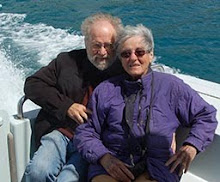Marian's still coughing and blowing and not feeling 100% so we took it easy today. We drove around Napier in the morning, up and down the narrow and curving streets on The Bluff, the nicer residential district on a hill above town, and looked down on Napier's little container port.
Then it was a choice between the national aquarium and a trip to a colony of gannets. Seen aquaria before, so...
This was to be a three-hour cross-country ride in a 4-wheel-drive bus so Marian opted to stay behind and relax in our van. As advertised the ride was an hour of bumping over a steep and narrow track...
...over a very hilly sheep ranch.
Funny story here. According to the guide, the first owner, back in 1890, was a scottish bank manager who bought it on the strength of a real-estate brochure, 5,000 acres of gently rolling fertile sheep land on Hawke's Bay. When he got here he found it was 5,000 acres, all right. That much was true.
Also worth a note: these very green hills, like our California hills, turn brown in late spring. This whole area is in a rain shadow of a mountain range.
Finally we reach Kidnap Point, so called by Captain Cook who had some sort of argy-bargy with the Maori here. There are three gannet colonies. The oldest, the Saddle colony, can be seen on this dramatic point.
It's been in the same place since 1890. On the top of the bluff is the Cliff colony, est. 1930. The bus parks right next to it.
The gannets who are home sit on their nest mounds, all facing into the wind, which was very strong and gusty today.
The male and female alternate guarding the nest and feeding. Even now, before they have laid their eggs, they have to guard it because if they didn't, their neighbors would filch the kelp they have collected as lining. So they sit and nap.
When fledged, a young gannet heads south to Wellington and then west over the Tasman sea to spend its first two years in Australia, nobody knows why. Then it comes back here to find a mate and set up housekeeping.
The one of the pair who's been out to sea fishing comes home.
It flies over the colony emitting a special "honey, I'm home" call.
Its mate sits up straight and calls back. The returnee puts down the flaps and lands.
Then they do a little necking and beak-stroking.
It is the male's job to bring back hunks of kelp to furnish the nest.
So that was that. Did the laundry for the last time in New Zealand: one week to go! Tomorrow we are off to Gisborne.























































